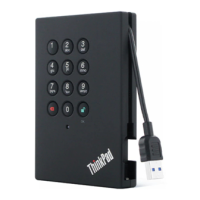Packets: Sent = 4, Received = 4, Lost = 0 (0% loss),
Approximate round trip times in milli-seconds:
Minimum = 2ms, Maximum = 2ms, Average = 2ms
Step 2. Issue a ppiinngg command from each host’s initiator address (the IP address of the host Ethernet port
used for iSCSI) to each controller iSCSI port. Perform this action from each host server in the
configuration, changing the IP addresses as necessary.
Note: If the command fails (for example, returns Packet needs to be fragmented but DF set), verify
the MTU size (jumbo frame support) for the Ethernet interfaces on the host server, storage
controller, and switch ports.
Create partitions and filesystems
A new LUN has no partition or file system when the Linux host first discovers it. You must format the LUN
before it can be used. Optionally, you can create a file system on the LUN.
Before you begin
The host must have discovered the LUN.
In the /dev/mapper folder, you have run the llss command to see the available disks.
You can initialize the disk as a basic disk with a GUID partition table (GPT) or Master boot record (MBR).
Format the LUN with a file system such as ext4. Some applications do not require this step.
Step 1. Retrieve the SCSI ID of the mapped disk by issuing the ssaannlluunn lluunn sshhooww --pp command.The SCSI ID
is a 33-character string of hexadecimal digits, beginning with the number 3. If user-friendly names
are enabled, Device Mapper reports disks as mpath instead of by a SCSI ID.
# sanlun lun show -p
DE-Series Array: ictm1619s01c01-SRP(60080e50002908b40000000054efb9d2)
Volume Name:
Preferred Owner: Controller in Slot B
Current Owner: Controller in Slot B
Mode: RDAC (Active/Active)
UTM LUN: None
LUN: 116
LUN Size:
Product: DE-Series
Host Device: mpathr(360080e50004300ac000007575568851d)
Multipath Policy: round-robin 0
Multipath Provider: Native
--------- ---------- ------- ------------ ----------------------------------------------
host controller controller
path path /dev/ host target
state type node adapter port
--------- ---------- ------- ------------ ----------------------------------------------
up secondary sdcx host14 A1
up secondary sdat host10 A2
up secondary sdbv host13 B1
Step 2. Create a new partition according to the method appropriate for your Linux OS release. Typically,
characters identifying the partition of a disk are appended to the SCSI ID (the number 1 or p3 for
instance).
# parted -a optimal -s -- /dev/mapper/360080e5000321bb8000092b1535f887a mklabel
gpt mkpart primary ext4 0% 100%
Chapter 2. System setup and configuration 87

